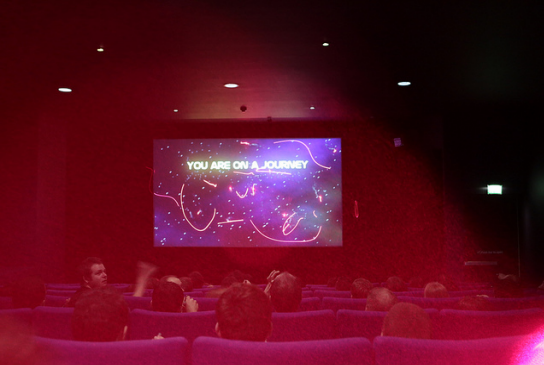By Joel Smart (The Cascade) – Email
Print Edition: March 6, 2013
Think back to the excitement you’ve felt sitting in a theatre amid a sold-out group of strangers waiting to see the premier of a highly-anticipated movie; now picture that crowd taking part in the action, playing the experience together – becoming teammates.
Imagine if you could mix the thrill of a massively multiplayer game like World of Warcraft—where dozens of real players can cooperate to take on extreme challenges—with the electric charge that comes from sitting next to your teammates. Sure, with laptops, it’s possible to play in close proximity. But, it would be on a whole different level if you could play a game with an entire theatre full of people, each person part of the action on a massive screen. Not only is it possible, it’s a reality.
Described by Gamasutra as a highlight at the New York City games festival IndieCade East, the world’s first 100-player laser game caught the attention of the gaming world with its fresh approach. Created by British developer wallFour, the game is called Renga. Along with its theatre-screen and massive local multiplayer, Renga is also quite innovative for its use of laser pointers as controllers. By shining their laser onto the screen, each person in the theatre is able to interact with the game. The goal? To help the game’s struggling protagonist to rebuild his ship, defeat the nemesis and return safely home. To steer the ship and keep it out of harm’s way, players need to collaborate by shining their lights at certain parts of the ship to cause it to move in that direction. As Gamasutra describes the gameplay, “Consensus by laser.”
While admittedly the story is cliché and the actual gameplay may not seem that enticing on paper, the focus on teamwork really drives the experience. In order to have success, multiple groups of people need to work together to simultaneously solve situations as they arrive. According to Dorkshelf’s Eric Weis, even the smallest tasks in the game require the cooperation of at least three players – and there can be dozens of tasks requiring attention at any given time. That means people need to solicit help and order commands to be successful – something that escalates as the hour-long game reaches its climax.
“One hundred players shout and scream at each other as the atmosphere builds to its joyous conclusion,” John Sear of wallFour told Gamasutra. “They arrive as an audience; they leave as a team.”
Renga isn’t actually the first theatre-operated massively multiplayer video game, however. In 1991, computer engineer Loren Carpenter created a game of Pong where two halves of a large audience took control of a respective Pong paddle. Each audience member was given a wand with a red and a green side. Green moved the paddle upwards, red moved it down. A computer system measured all the responses at once – so if the left side of the auditorium all turned their wands to show red, the left paddle moved at maximum speed to one side. In order to succeed, some players would have to turn their paddles to green to slow the paddle’s movement at points in the game. Only by working together could they coordinate to hit the ball. Amazingly, the group of strangers were able to do just that, suggesting that non-hierarchical, democratic governance is truly possible.
While neither Renga not theatre Pong are likely to go mainstream anytime soon, they are welcome additions to the world of gaming. They show us that there is so much potential for this medium. If theatre gaming continues to evolve and gain momentum, we could be in for a very wild ride.



